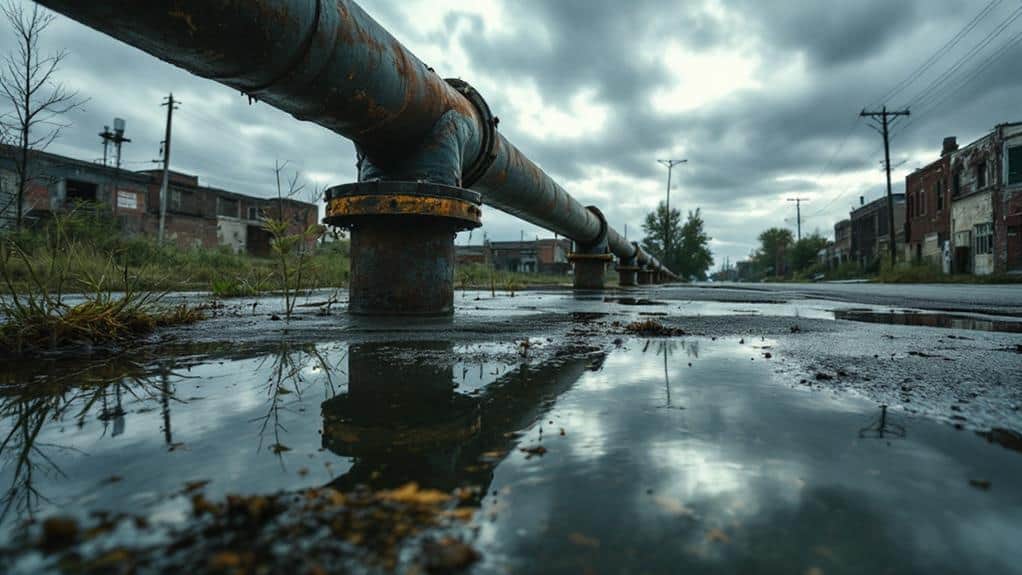Introduction: Transforming Detroit's Water Infrastructure Challenges
While the term "lead legacy" might sound like a burden, it actually presents Detroit with a unique opportunity for growth.
You're looking at a city where replacing aging infrastructure isn't just about fixing pipes; it's about stimulating the local economy and enhancing community well-being.
By tackling these water challenges head-on, Detroit can attract investments and create jobs, setting a precedent for other cities.
But what are the tangible steps needed to turn this vision into reality?
And how can Detroit guarantee these efforts lead to long-term benefits?
The answers lie just beneath the surface.
Understanding Detroit's Water Crisis
Detroit's water crisis isn't just a recent concern; it's been building over decades due to aging infrastructure and industrial neglect. You mightn't realize it, but the quality of the water you use every day has a profound impact on community health and well-being.
When infrastructure starts to falter, the water quality suffers, posing risks to everyone who relies on it. But here's where the story takes an inspiring turn: it's precisely in these challenging times that community resilience truly shines.
Imagine neighborhoods coming together, advocating for cleaner, safer water, and demanding the changes necessary to safeguard their futures. You're part of a community that doesn't just wait for solutions but actively seeks them. This strength and determination can drive meaningful improvements, ensuring every household can trust the water flowing from their taps.
In understanding the depth of Detroit's water crisis, you're not just seeing the problem; you're recognizing the power of collective action. Together, you have the ability to transform adversity into opportunity, pushing for innovations and investments that can rebuild and modernize the water systems.
It's about turning a legacy of neglect into a future of hope and strength.
Historical Context of Lead Contamination
Imagine a time when the promise of progress led to the widespread use of lead pipes in cities like Detroit, believed to be safe and resilient.
As you reflect on this, consider the long-term impact these decisions have had on public health, leaving a legacy that still challenges us today.
Origins of Lead Pipes
Picture the bustling cities of the late 19th century, where the gleam of new infrastructure promised progress and prosperity. Imagine the excitement as cities expanded, and the need for efficient water systems grew. Lead pipe origins trace back to this era, when the demand for durable and flexible materials led engineers to favor lead. The metal's pliability made it an ideal choice for the intricate web of pipes needed to carry water into homes and businesses, shaping the historical manufacturing landscape.
You can almost see the skilled artisans, working tirelessly in factories, crafting pipes that would become essential arteries of urban life. They believed in the promise of lead, unaware of the legacy they were creating. It was a time of innovation, where people prioritized immediate benefits without foresight of long-term consequences. The affordability and ease of installation made lead pipes the popular choice, cementing their place in the infrastructure of growing cities like Detroit.
Reflect on this period as a lesson, showing how choices made with good intentions can have unforeseen impacts. As you understand these origins, you gain insight into the challenges faced today, empowering you to envision solutions for a healthier future.
Impact on Public Health
For many, the allure of progress overshadowed the lurking dangers of lead. As cities like Detroit grew, lead pipes seemed like the perfect solution for durable infrastructure. But beneath this facade, lead poisoning quietly threatened public health, particularly in vulnerable communities.
You might wonder why it took so long for public awareness to catch up. Health disparities grew, affecting childhood development and causing lifelong challenges.
In the heart of this issue lies the concept of environmental justice. Communities, often marginalized, bore the brunt of these health impacts, highlighting stark inequities.
But there's hope. Community resilience has shone through, driving change and demanding justice. People have come together, using their voices to advocate for policy changes that prioritize safe water and equitable healthcare access for all.
As you reflect on this legacy, consider the power of policy advocacy. It's not just about identifying problems but pushing for solutions that protect future generations.
By raising awareness and supporting initiatives that prioritize the health of all citizens, you can be part of a movement that turns past mistakes into opportunities for growth and healing.
Together, you can help build a healthier and more just future.
Health Impacts on the Community
You mightn't realize it, but lead exposure can silently impact your health, causing issues like developmental delays in children and kidney problems in adults.
However, the community isn't standing still; they're launching health initiatives and programs aimed at reducing these risks and improving overall wellness.
Lead Exposure Health Risks
Lead exposure poses significant health risks to communities, particularly in cities like Detroit, where aging infrastructure and industrial legacies contribute to the problem. You may find it alarming, but understanding these risks is essential for lead poisoning prevention and ensuring a safer environment.
Exposure to lead can lead to severe health issues, especially in children, affecting their development and well-being.
Consider these key impacts:
- Cognitive Effects: Lead exposure can lower IQ levels, slow growth, and impair learning abilities in children. It can be devastating to watch a child struggle with tasks others find simple.
- Behavioral Changes: Exposure can lead to increased aggression, attention disorders, and hyperactivity. It's not just an individual issue; such changes ripple through families and neighborhoods.
- Physical Health Risks: Lead can cause anemia, kidney damage, and even affect the nervous system. The physical toll it takes can be relentless, affecting daily life and long-term health.
Community education plays a vital role in addressing these challenges. By spreading awareness, you empower yourself and others to demand better infrastructure and safer environments.
Together, we can turn adversity into opportunity, creating a healthier and brighter future for everyone.
Community Health Initiatives
Addressing the far-reaching health impacts of lead exposure requires robust community health initiatives. You might wonder how you can make a difference, but every step counts.
Community wellness programs serve as a cornerstone in this effort, offering resources to promote healthier lifestyles and environments. These programs are designed to strengthen the community's ability to tackle lead exposure, focusing on preventative care and wellness checks that catch issues early.
Health education campaigns play an essential role in empowering you with knowledge. By participating, you learn about the dangers of lead and ways to mitigate its effects. These campaigns often include workshops and informational sessions that aren't just educational but also inspiring. They remind you that understanding and action can lead to real change.
Imagine a community where everyone knows how to protect themselves and their families from lead exposure. Visualize neighbors coming together at local centers, engaging in discussions that spark innovation and resilience.
Your involvement in these initiatives not only protects your health but also strengthens the community bond. Together, by focusing on awareness and prevention, you create a healthier future for everyone.
Your actions today can lead to a legacy of wellness and safety for generations to come.
Current Infrastructure Challenges
Decaying infrastructure poses a significant challenge for Detroit, as aging pipelines and outdated systems continue to threaten the city's water quality.
This situation calls for immediate attention and action, urging you to reflect on the essential necessity of infrastructure upgrades. The crumbling systems not only impact the water quality but also the health and safety of the entire community.
It's imperative to understand the importance of addressing these challenges and envisioning a future where clean, safe water is a guarantee for every resident.
You might wonder how Detroit can turn these challenges into opportunities. Here's a clear path forward:
- Infrastructure Upgrades: Prioritize replacing old pipelines and updating systems to guarantee the consistent delivery of high-quality water.
- Community Engagement: Involve residents in discussions and decisions about water infrastructure projects, fostering a sense of ownership and empowerment.
- Technological Innovation: Embrace new technologies to monitor and maintain water systems, preventing future issues and enhancing efficiency.
Funding and Investment Strategies
You have the power to transform Detroit's future through innovative funding and investment strategies that bring hope and renewal.
By embracing public-private partnership models, you can help create a collaborative environment where resources and expertise combine to tackle the city's lead challenges.
Imagine a city where innovative financing solutions turn dreams of safe, lead-free communities into reality, proving that together, we can overcome any obstacle and build a brighter future for everyone.
Public-Private Partnership Models
In tackling Detroit's enduring lead contamination issues, one effective strategy is the implementation of public-private partnership models.
These partnerships leverage collaborative governance and risk management to transform challenges into opportunities. By sharing responsibilities and resources, you can create powerful alliances that drive meaningful change.
Here are three ways these partnerships can work:
1. Collaborative Governance: This involves government entities and private companies working closely to set clear goals and align their efforts.
By fostering open communication and transparency, you guarantee that all parties remain committed to the shared vision of a lead-free Detroit.
2. Risk Management: Public-private partnerships enable the distribution of risks, making large-scale projects more feasible.
Through shared liability, you reduce the burden on any single entity, encouraging more stakeholders to invest in Detroit's water infrastructure.
3. Resource Optimization: Combining public resources with private sector expertise allows for efficient use of funds and technology.
This synergy can lead to innovative solutions and faster implementation, guaranteeing that the community benefits from improved water safety sooner rather than later.
Innovative Financing Solutions
Building on the foundation of public-private partnership models, exploring innovative financing solutions becomes a natural progression in addressing Detroit's lead contamination crisis.
You've seen the challenges, and now is the time to turn them into opportunities. Green financing offers a path forward, channeling investments into sustainable and environmentally friendly projects. By embracing green bonds and loans, you can attract investors who are enthusiastic to support initiatives that not only address lead contamination but also promote cleaner, healthier communities.
Consider the social impact of these investments. When you invest in water infrastructure improvements, you're not just fixing pipes—you're transforming lives. Families gain access to safe drinking water, children grow up healthier, and communities thrive. This is where social impact bonds come into play, aligning financial returns with positive community outcomes.
You're part of a movement that values people and the planet over short-term profits.
Now, imagine the ripple effect. As you implement these financing solutions, you're setting an example for other cities facing similar challenges. By leading with vision and determination, you're proving that it's possible to innovate, invest wisely, and create lasting change for generations to come.
Role of Public-Private Partnerships
Recognizing the complex challenges posed by lead contamination, Detroit has increasingly turned to public-private partnerships to tackle this pressing issue. These partnerships embody collaborative governance, bringing together government entities and private organizations to harness shared resources. By pooling expertise and financial support, they enhance infrastructure resilience and promote sustainable practices.
- Risk Management: Through shared responsibilities, these partnerships distribute risks, guaranteeing that no single entity bears the entire burden. This approach aligns with regulatory frameworks, fostering a safer and more effective response to lead contamination.
- Economic Incentives: Partnerships provide economic incentives that encourage businesses to invest in long-term planning and infrastructure improvements. These investments not only address immediate challenges but also create community benefits, enhancing public health and safety.
- Stakeholder Engagement: Engaging various stakeholders, from residents to policymakers, guarantees that diverse perspectives are considered. This inclusive process builds trust and promotes transparency, leading to solutions that reflect the community's needs.
Innovative Technological Solutions
Detroit's public-private partnerships lay the groundwork for addressing lead contamination, but innovation takes center stage in the fight against this persistent issue.
You can be part of the solution by embracing cutting-edge technology that transforms the way we manage water safety. Imagine smart sensors working tirelessly, embedded in the city's water infrastructure, detecting lead levels in real time. These smart sensors act like vigilant guardians, alerting authorities to potential threats before they escalate. It's a proactive approach, ensuring that clean water flows into every home.
But that's not all. Water filtration technology is evolving too, becoming more efficient and accessible.
Picture advanced filtration systems that can be installed at various points in the water distribution network or directly in households. These systems effectively remove contaminants, including lead, providing families with safe water to drink and use. By investing in these technologies, you're not just solving a problem; you're creating opportunities for safer, healthier communities.
As Detroit transforms its water infrastructure, you have the chance to witness and support a city leading by example.
Embrace these innovative solutions, and together, let's build a future where clean water is a given, not a goal.
Community Engagement Initiatives
A significant aspect of tackling lead contamination involves empowering the community to take an active role in the solution. You can play an essential part in this transformative journey through community workshops and educational outreach.
These platforms not only educate but fuel local advocacy and resident empowerment. By understanding the challenges and solutions, you'll find the strength to make impactful changes. It's all about turning awareness into action, ensuring everyone's voices are heard.
To further amplify these efforts, reflect on engaging in stakeholder collaboration and grassroots movements. Here, you'll see how joining forces with diverse groups can spark innovative ideas and drive meaningful change.
Participatory budgeting and civic engagement provide pathways for you to influence decisions that affect your neighborhood directly, ensuring that resources are allocated where they're needed most.
Here are three key initiatives to reflect on:
- Community Workshops: Attend sessions that inform and engage, turning knowledge into power.
- Participatory Budgeting: Get involved in deciding how public funds are spent, making sure your community's needs are prioritized.
- Local Advocacy: Support or start movements that push for policy changes, ensuring long-term solutions.
Economic Growth Opportunities
When you look closely, you'll see that addressing lead contamination isn't just about problem-solving—it's a chance to access economic growth opportunities in Detroit. Transforming aged water infrastructure isn't merely a fix; it's a pathway to economic revitalization.
Imagine the potential of creating new jobs and bolstering local businesses as you commence on this journey. By investing in safe water systems, you not only protect health but also forge a future brimming with economic promise.
Think about workforce development. As Detroit tackles its lead challenges, there's a need for skilled workers to rebuild and innovate. This creates chances for training programs that equip residents with valuable skills, empowering them to secure stable jobs and contribute to their community's prosperity.
You're not just building infrastructure; you're building lives, futures, and a stronger Detroit.
Imagine the ripple effects. When you invest in people and infrastructure, businesses thrive, communities flourish, and the city's economy grows. You have the power to turn adversity into opportunity, transforming Detroit into a beacon of resilience and renewal.
Embrace this moment, and watch as Detroit's economy evolves, bringing hope and prosperity to the heart of the city.
Detroit as a Model City
Imagine Detroit leading the nation as a model city for addressing urban challenges.
Picture a community where resilient infrastructure and sustainable practices transform the landscape and the lives of its residents. You might wonder how Detroit can become this beacon of progress.
By focusing on three key areas, the city can set a new standard for urban renewal:
- Resilient Infrastructure: By investing in innovative materials and technologies, Detroit can fortify its water systems against future crises. Creating a robust network not only safeguards public health but also attracts businesses keen to invest in a stable environment.
- Sustainable Practices: Embracing eco-friendly solutions can reduce the city's carbon footprint and enhance quality of life. Imagine green spaces flourishing amidst the urban sprawl, offering residents clean air and recreational areas, while promoting biodiversity.
- Community Engagement: Empowering residents with education and involvement in decision-making guarantees that solutions reflect the community's needs. When people are part of the process, they take pride in their city and work collectively to maintain and improve it.
Conclusion
Investing in a New Era for Detroit
Imagine a Detroit where clean water flows freely, and lead pipes are relics of the past.
You're not just witnessing a transformation; you're part of it.
By investing in water infrastructure, you're fueling economic revival and breathing life into communities.
While others may drown in challenges, Detroit's turning its water woes into a fountain of opportunity.
Join us in raising a glass—not of lead-tainted water, but of hope—to a city that's reclaiming its future, one pipe at a time.
Take action now and become a catalyst for change.
Together, let's pave the way for a healthier, more prosperous Detroit.





















